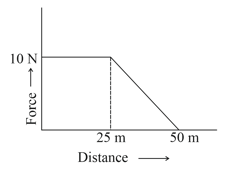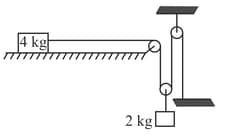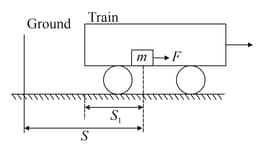A rigid body of mass initially at rest is moved by a horizontal force of on a frictionless table. Calculate the work done by the force on the body in and prove that this equals the change in kinetic energy of the body.

Important Questions on Work, Energy and Power
A body of mass initially at rest moves under the action of an applied horizontal force of on a table with the coefficient of kinetic friction . Compute the
(a) work done by the applied force in .
(b) work done by the friction in .
(c) work done by the net force on the body in .
(d) change in kinetic energy of the body in , and interpret your results.
A body of mass is acted upon by a variable force. The force varies with the distance covered by the body. What is the speed of the body when the body has covered ? Assume that the body starts from rest.

Consider the situation shown in the figure. Initially the spring is undeformed when the system is released from rest. Assuming no friction in the pulley, find the maximum elongation of the spring.

A rigid body of mass is taken slowly up an inclined plane of length and height (assuming the applied force to be parallel to the inclined plane), and then allowed to slide down to the bottom again. The coefficient of friction between the body and the plane is Using find the

(a) work done by the gravitational force over the round trip.
(b) work done by the applied force over the upward journey
(c) work done by frictional force over the round trip.
(d) kinetic energy of the body at the end of the trip?
As shown in the figure, there is pulley-block system. The system is released from rest and the block of mass is found to have a speed after it has descended through a distance of . Find the coefficient of kinetic friction between the block and the table.

A block of mass sits at rest on a frictionless table in a train that is moving with speed (w.r.t. ground) along a straight horizontal track (figure). A person in the train pushes on the block with a net horizontal force for a time in the direction of the car’s motion.

(i) What is the final speed of the block according to a person on the train?
(ii) What is the final speed of the block according to a person standing on the ground outside the train?
(iii) How much did the kinetic energy of the block change according to the person in the car?
(iv) How much did the kinetic energy of the block change according to the person on the ground?
(v) In terms of and how far did the force displace the object according to the person in the car?
(vi) According to the person on the ground?
(vii) How much work does each say the force did?
(viii) Compare the work done to the gain according to each person.
(ix) What can you conclude from this computation?
